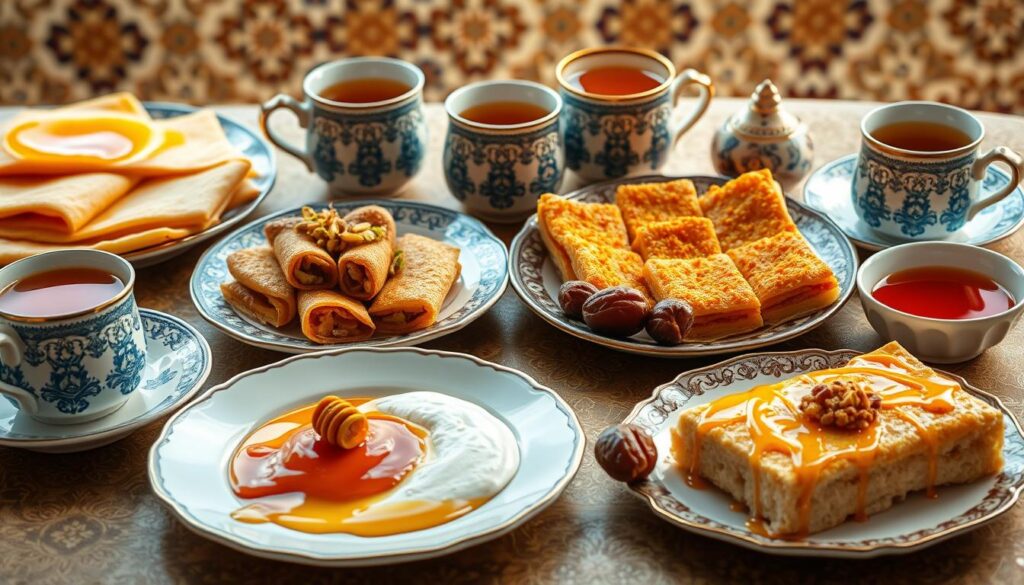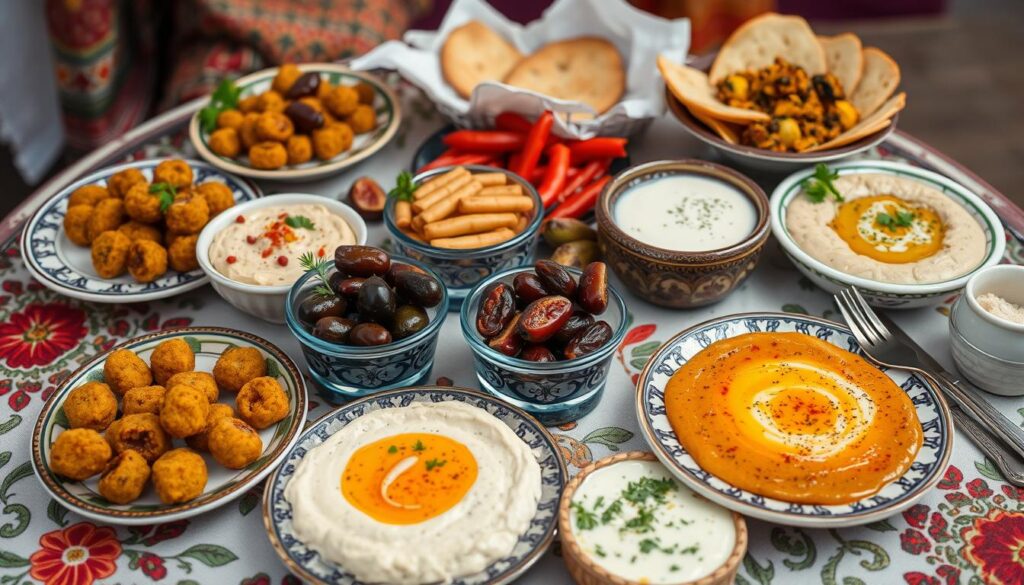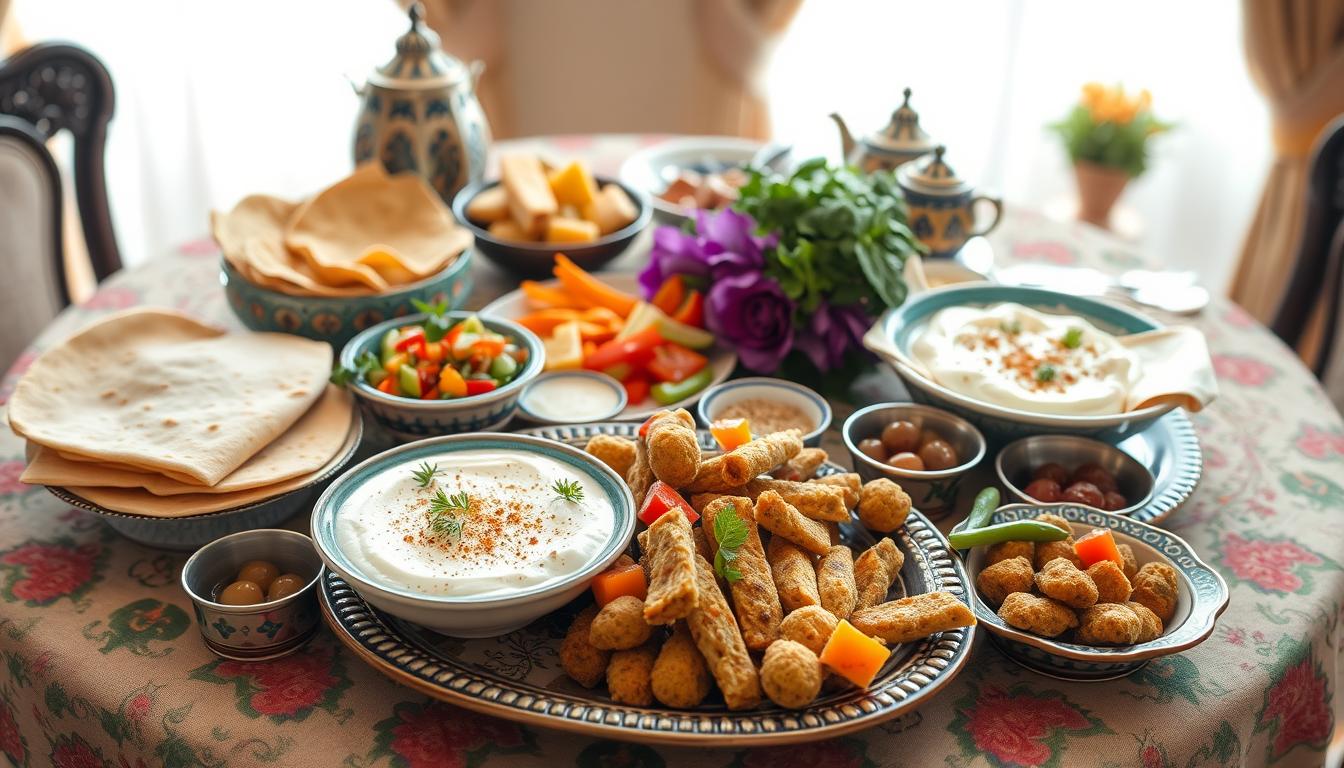Growing up in a Middle Eastern home, I loved the smells of spices and the sound of flatbreads sizzling. The Arabic breakfast was more than food; it was a cultural tradition. It showed the history, family, and daily rituals of our region.
Exploring Arabic breakfast, you’ll find a world of flavors and textures. From za’atar on manakish to creamy labneh, each dish has its own story. These stories are about the land, people, and traditions of the Middle East.
Table of Contents
Understanding the Significance of Arabic Breakfast Culture
In Arab culture, breakfast is more than just a meal. It’s a time for family to come together. This is especially true on weekends and holidays. It’s a chance for loved ones to enjoy tasty food and meaningful talks.
Family Gathering and Social Bonding
Saudi breakfast is a big deal for families. It shows the importance of family in the region. Families sit down together, enjoying traditional dishes and sharing stories.
This shared breakfast time is key to Middle Eastern society. It strengthens family bonds and creates lasting memories.
Traditional Breakfast Times and Customs
Arabic breakfast is not just about the food. It’s also about the traditions and customs. The timing of breakfast varies, but hospitality is always key.
Hosts often serve a lot of food as a sign of respect. Guests are encouraged to enjoy every bite. Cultural items like dates and honey add to the meal’s significance.
Cultural Importance in Middle Eastern Society
Arabic breakfast is deeply rooted in Middle Eastern culture. It reflects the region’s rich heritage and culinary traditions. The dishes are not only nutritious but also highlight sustainability and reducing food waste.
“Breakfast in the Arab world is not just about the food; it’s also about the traditions and customs that surround it.”
Essential Components of Arabic Breakfast
Arabic breakfast is a culinary delight that brings together flavors and nutrients. It has essential components that define Middle Eastern cuisine. From bread varieties to savory dips, each element is crucial for a balanced breakfast.
Bread is the cornerstone of an Arabic breakfast. Khubz, a traditional flatbread, is a staple. It’s often served with foul mudammas (fava beans), eggs, and cheeses. Dates, known for their nutritional value, are the first food eaten, setting the meal’s tone.
Honey is a significant part of Arabic breakfast, served with bread and cheese. The spread may also include labneh (strained yogurt), hummus, and baba ghanoush. These provide a mix of proteins, carbs, and healthy fats to start the day.
| Arabic Breakfast Components | Middle Eastern Breakfast Ingredients |
|---|---|
| Khubz (Flatbread) | Fava Beans (Foul Mudammas) |
| Eggs (Various Preparations) | Cheese |
| Olives | Vegetables (Cucumbers, Tomatoes) |
| Dates | Honey |
| Labneh (Strained Yogurt) | Hummus |
| Baba Ghanoush | Spices (Za’atar, Sumac, Cumin) |
These components of an Arabic breakfast provide a nourishing start to the day. Each ingredient, with its unique flavor and nutritional profile, shows the culinary traditions and cultural significance of this meal.
Popular Bread Varieties in Middle Eastern Breakfast
Bread is key in the traditional Arabic breakfast. The Middle East has many breads, each with its own taste and use. From the common khubz to the thin kimaj, these breads are perfect for scooping up dishes or enjoying with sweet toppings.
Khubz and Its Variations
The khubz is a staple in many Middle Eastern countries. It comes in different forms, like tamees and mafrood. These breads are great for scooping up hummus, baba ganoush, and stews, making meals more fun.
Traditional Flatbreads and Their Uses
There’s more to Middle Eastern breads than just khubz. The kimaj is a thin, crispy bread perfect for toppings. The girde is thick and circular, great with cheese, honey, and other breakfast items.
Regional Bread Specialties
Each region in the Middle East has its own bread specialty. The mallah bread is soft when fresh and crispy when cooled. In Morocco, the msemen and rghaif are loved for their flaky texture, often enjoyed with dips.
| Bread Variety | Description | Common Uses |
|---|---|---|
| Khubz | Round flatbread | Scooping up dishes, eating on its own |
| Tamees | Large, thin flatbread | Scooping up dishes, eating on its own |
| Kimaj | Thin, crispy bread | Eating on its own, as a base for toppings |
| Mafrood | Thin bread with fennel seeds | Scooping up dishes, eating on its own |
| Girde | Thick circular bread | Eating with cheese, honey, and other breakfast items |
| Mallah | Soft when fresh, crispy when cooled | Eating on its own, with breakfast items |
| Msemen | Flaky, layered Moroccan bread | Eating with traditional dips and spreads |
| Rghaif | Flaky, layered Moroccan bread | Eating with traditional dips and spreads |
These Arabic bread and Middle Eastern flatbread varieties show the rich culinary traditions of the region. Each has its own flavor, texture, and cultural importance. They are key to the traditional Arabic breakfast, used for scooping, serving as a base, or enjoyed on their own.
Savory Dishes in Arabic Breakfast
Traditional Arabic savory breakfast dishes offer a wide variety of flavors. You’ll find favorites like foul mudammas (fava beans with olive oil and spices) and shakshuka (eggs poached in tomato sauce). These dishes make for a hearty and fulfilling morning.
Middle Eastern breakfast foods also include creamy hummus, smoky baba ghanoush, and fresh tabbouleh salad. Coastal areas might add fresh fish to the breakfast menu, giving it a unique flavor.
These dishes are not just tasty; they also showcase the Arab world’s rich culture and food traditions. Whether you’re enjoying a mutabbaq (stuffed pancake) or a variety of dips, the Arabic savory breakfast dishes are a delicious way to start your day.
| Dish | Description |
|---|---|
| Foul Mudammas | Fava beans cooked in olive oil and seasoned with spices |
| Shakshuka | Eggs poached in a tomato-based sauce with peppers and onions |
| Mutabbaq | Stuffed pancake filled with meat, eggs, and other ingredients |
| Hummus | A creamy dip made from chickpeas, tahini, lemon, and garlic |
| Baba Ghanoush | A smoky eggplant-based dip with tahini, lemon, and spices |
| Tabbouleh | A refreshing salad made with bulgur, parsley, tomatoes, and mint |
Adding Arabic savory breakfast dishes to your morning can be both satisfying and nutritious. It also gives you a taste of the Middle East’s rich culinary heritage.
The Role of Eggs in Traditional Arabic Breakfast
Eggs are key in the traditional Arabic breakfast. Shakshuka, a dish from North Africa, is very popular in the Middle East. It has eggs poached in a sauce of tomatoes, bell peppers, and spices.
Arabic breakfasts also include many other egg dishes. Fluffy omelets are often on top of balaleet, a sweet vermicelli dish. This makes eggs a must-have in Arabic breakfasts.
| Egg Dish | Description |
|---|---|
| Shakshuka | Eggs poached in a sauce of tomatoes, bell peppers, and spices |
| Omelet | Fluffy egg-based dish, often served with additional toppings |
| Balaleet | Sweet vermicelli-based dish topped with a layer of eggs |
Eggs are used a lot in Arabic breakfast dishes. They are great because they are nutritious and can be used in many ways. Whether in a savory sauce, an omelet, or on a sweet dish, eggs are a great source of protein.
“The egg is the foundation of so many Middle Eastern breakfast dishes, from the iconic shakshuka to the humble but delicious omelets. It’s a versatile ingredient that adds protein, texture, and flavor to the morning feast.”
Sweet Elements of Arabic Breakfast
Sweet treats are a big part of the Arabic breakfast. Dates are a favorite, enjoyed to break the fast. They are sweet and loved in the morning. Paired with honey, bread, or cheese, they’re a treat.
Balaleet is another sweet dish, made with saffron. It’s flavored with cardamom and topped with pistachios. This dish is a unique twist to morning food.
- Dates, a staple in Arabic sweet breakfast
- Honey, commonly used to complement bread and cheese
- Balaleet, a saffron-flavored vermicelli dish
- Pastries and fruit preserves as other sweet options
The Middle Eastern traditions shine in Arabic breakfasts. Dates, honey, and Balaleet are just a few examples. These sweets add to the rich flavors of Arabic sweet breakfast and Middle Eastern breakfast sweets.
| Sweet Dish | Description |
|---|---|
| Dates | Succulent, naturally sweet fruits often enjoyed to break the fast |
| Honey | Drizzled over bread, cheese, or used as a topping |
| Balaleet | Saffron-infused vermicelli dish, flavored with cardamom and sometimes topped with pistachios |
| Pastries and Preserves | Various sweet pastries and fruit preserves as additional morning delights |

“The sweetness of an Arabic breakfast is a reflection of the warmth and hospitality that permeates the culture.”
Arabic Coffee and Tea Traditions
Coffee and tea are very important in the Middle East. Arabic coffee, also known as Saudi coffee, is a big part of breakfast. It’s made in a special pot called a “dallah” and has cardamom, saffron, or cloves. It’s served in small cups, showing respect for guests.
Tea is also loved in the Middle East. There are many herbal teas with different tastes. The way tea is served is very important, with its own rules.
Coffee Preparation Methods
Making Arabic coffee is a tradition passed down through generations. The beans are roasted and ground finely. They’re then brewed in a dallah over a small flame.
The brew is watched carefully to get the right strength and smell.
Tea Serving Customs
Serving tea in the Middle East shows great respect for guests. Tea is in colorful cups and sometimes on fancy trays. The host pours the tea high up, making a nice foam.
Traditional Accompaniments
Arabic coffee and tea come with sweets and dates. You might get baklava, qatayef, and pastries. These treats make the breakfast feel more special.
The way coffee and tea are made and served shows their importance in the Middle East. These traditions show respect, hospitality, and cultural identity.
Regional Variations in Arabic Breakfast
The Arabic breakfast is a colorful mix of flavors from different places. Each area has its own special dishes. From the Levantine meze platters to the Arabian Peninsula’s kabsa, the Middle East’s tastes are as rich as its cultures.
In Egypt, breakfast often includes Ful medames – seasoned fava beans with tahini, parsley, and boiled eggs. In Nigeria, the Hausa enjoy kosai and funkaso. The Yoruba prefer Ògì or Gari.
In the Horn of Africa, Somali breakfasts feature shaah (tea) with canjeero (a bread-like pancake) and sometimes maraq (stew or soup). Tunisia’s breakfasts show French influence, with Lablabi (stew) and Baguette with jam and butter.
| Region | Signature Breakfast Dishes |
|---|---|
| Egypt | Ful medames |
| Nigeria | Kosai, Funkaso, Ògì, Gari |
| Somalia | Shaah, Canjeero, Maraq |
| Tunisia | Lablabi, Baguette with jam and butter |
The variety of Arabic breakfast variations goes beyond these examples. Each Middle Eastern regional breakfast shows off local ingredients, cultural influences, and history. This colorful mix of flavors and traditions highlights the richness of Arabic breakfasts.

Healthy Aspects of Traditional Arabic Breakfast
Traditional Arabic breakfast is packed with nutrients. It has complex carbs from fresh breads, proteins from eggs and legumes, and healthy fats from olive oil.
Fresh fruits and veggies are a big part of this meal. Shakshuka, a dish with eggs, tomatoes, bell peppers, and onions, is full of vitamins and minerals. Leafy greens like molokhiya add even more nutrition.
Dates are also a key part. They are sweet and full of fiber, potassium, and minerals. They make the breakfast even healthier.
| Nutrient-Dense Ingredients in Traditional Arabic Breakfast | Nutritional Benefits |
|---|---|
| Whole Grains (Breads like Khubz) | Complex carbohydrates, fiber, B vitamins, minerals |
| Eggs | High-quality protein, vitamins, minerals |
| Legumes (Foul Medames, Lentils) | Plant-based protein, fiber, folate, iron |
| Olive Oil | Monounsaturated fats, antioxidants |
| Fruits and Vegetables | Vitamins, minerals, antioxidants |
| Dates | Fiber, potassium, magnesium |
The variety of dishes in a traditional healthy Arabic breakfast makes it very nutritious. It’s a great way to start the day with a balanced meal. This nutritional Middle Eastern breakfast is delicious and nourishing.
Modern Interpretations of Arabic Breakfast
In the Arab world, the first meal of the day has changed with modern life. Urban areas now see a mix of old and new in breakfast traditions.
Contemporary Adaptations
Weekdays are busy, so many Arabs grab quick breakfasts like yogurt or smoothies. But on weekends, families enjoy a big, slow breakfast with traditional flavors.
People are now adding more fruits and veggies to their breakfasts. This change is about finding a balance between old tastes and new health needs. It’s a response to growing health issues like obesity and diabetes.
Fusion Elements in Modern Presentations
The world of hotels has brought new breakfast ideas to the Arab world. Hotels offer many breakfast choices, introducing new tastes to locals. This mix of cultures has led to new breakfast dishes that blend old and new.
Shakshuka, a North African favorite, now comes with avocado or feta. These changes keep the dish’s spirit alive while adding something new. Such contemporary Middle Eastern breakfast dishes show how recipes can evolve and stay true to their roots.
“The fusion of traditional Arabic flavors with global culinary trends has resulted in a rich tapestry of innovative breakfast options, catering to the diverse tastes of today’s Arab consumer.”
Conclusion
The traditional Arabic breakfast is more than just food. It shows the region’s history, values, and love for guests. It’s a unique experience that keeps changing but stays true to its roots.
With its mix of savory and sweet dishes, and the special ritual of coffee and tea, it highlights the Middle East’s rich food culture. This tradition is a symbol of the area’s diversity and richness.
Even with modern changes, the Arabic breakfast’s importance in Middle Eastern society remains strong. The joy of sharing meals together, using fresh ingredients, and following cultural and religious food rules make it special.
Exploring Arabic breakfast takes you on a journey that goes beyond just eating. It helps you appreciate the vibrant culture and the values of hospitality, family, and togetherness. These values are at the heart of this cherished mealtime ritual.

